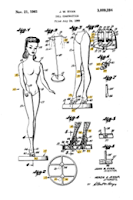During this holiday season, I recall the adage that it is better to give than to receive. But being completely honest, most children really enjoy getting presents too. And not just any presents, but often the hottest toy, the newest fad, or the trendiest clothes. In A Christmas Story, young Ralphie famously wants “an official Red Ryder carbine-action 200-shot range model air rifle,” and goes to great extremes to make sure his parents, his teacher, and especially Santa Claus know. Toy companies are well-aware of these desires. Marketing efforts are devised to penetrate the subconscious thoughts of children leading to a manic frenzy on Black Friday for an Xbox gaming console, Pokemon cards, or a Tickle Me Elmo doll that have become “must haves.” Not surprisingly, given the great demand for these items, entrepreneurs who invent toys and the companies who work to market them will ensure that their toys, games and dolls are adequately protected by intellectual property rights to prevent cheap knockoffs and grow their market share. Even Ralphie’s Red Ryder air rifle was patented by Daisy Outdoor Products on October 2, 1888 as U.S. Patent No. 390,311, titled “Spring Air Gun.”
The vast majority of iconic toys have been protected by patents in some form. Certainly others have written about this over the years. As all patents are publicly available, one can easily review the patents issued on these legendary toys and games and learn about many groundbreaking innovations that we now take for granted. Coupled with a strong trademark, fancy designs, and clever marketing, these toys and games have become engrained into our nostalgic memories, harkening back to our youths and evoking more innocent times.
 Some famous toys may not have been the first to the market, but they were able to improve upon prior designs and gained exclusive patent protection for new innovations. The first Teddy Bear, invented by the Ideal Toy Company in 1902 in honor of President Theodore Roosevelt, was not patented. However, many subsequent versions of Teddy Bears and stuffed animals have been patented since, focusing on new features and designs. For example, U.S. Patent No. 1,359,398, titled “Toy Animal,” was issued on November 16, 1920 to Jacob Levine for a Teddy Bear that made an audible tone when a child grabbed its arm. On May 19, 1987, U.S. Patent No. 4,665,640, titled “Electromechanical Controller,” was issued for features of an animatronic toy, called Teddy Ruxpin, with facial movements coordinated with an audio track.
Some famous toys may not have been the first to the market, but they were able to improve upon prior designs and gained exclusive patent protection for new innovations. The first Teddy Bear, invented by the Ideal Toy Company in 1902 in honor of President Theodore Roosevelt, was not patented. However, many subsequent versions of Teddy Bears and stuffed animals have been patented since, focusing on new features and designs. For example, U.S. Patent No. 1,359,398, titled “Toy Animal,” was issued on November 16, 1920 to Jacob Levine for a Teddy Bear that made an audible tone when a child grabbed its arm. On May 19, 1987, U.S. Patent No. 4,665,640, titled “Electromechanical Controller,” was issued for features of an animatronic toy, called Teddy Ruxpin, with facial movements coordinated with an audio track.Similarly, U.S. Patent No. 3,009,284, titled “Doll Construction,” was issued on November 21, 1961, but certainly was not the first doll design created, itself having purportedly been modelled on a German doll named the Bild Lilli. However, this new doll had a body and limbs in articulated relationship and means for supporting the doll in an upright or standing position for display or storage. It also had a catchy name – the Barbie doll – and has been an iconic doll for over 60 years.
Some iconic toys drew inspiration from other sources that were not toys or games. U.S. Patent No. 1,351,086, entitled “Toy-Cabin Construction,” was issued on August 31, 1920 to John Lloyd Wright, son of famous architect Frank Lloyd Wright. The younger Wright developed his toy cabin building blocks after being exposed to earthquake-resistant architectural designs in Japan. His blocks, called Lincoln Logs, comprised a plurality of different sized notched pieces that could be interconnected to create a variety of cabin designs.






No comments :
Post a Comment